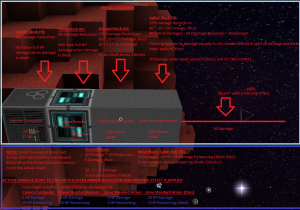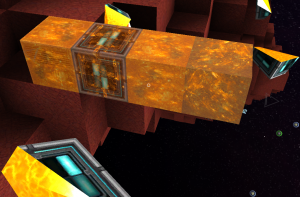Difference between revisions of "Defense Systems"
DukeofRealms (talk | contribs) (Imported page) |
(No difference)
|
Revision as of 02:47, 9 July 2016
In StarMade, each block has a hit point (HP) and an armor value. If a block is hit by any offensive weapon, the HP value of the block is lowered. If a block's HP is lowered to zero, the block is destroyed.
A pilot is instantly killed if the Ship Core is destroyed. The empty ship can then be looted, salvaged, or left in space for a short period before the core explodes (unless a player initiates a reboot before the timer is up by approaching the core in Astronaut Mode and pressing R).
Shields
Shields are currently the most useful defensive system. They are made of two blocks, the Shield Capacitator and the Shield-Recharger. The amount of shield health, and speed of regeneration, are set by the amount of Shield Capacitators and Shield-Rechargers on the ship. While your ship has any amount of shield health remaining, no blocks can be destroyed. As soon as all shields are depleted, the ship's blocks will begin taking damage.
Once a ship's shields have been fully depleted, they will stop recharging for 10 seconds. After this 10 seconds has elapsed, the shields will begin recharging once more. However, if the ship is still taking damage, it is likely that they will be rapidly depleted again, and another 10 second recovery time will begin.
Unlike most other ship systems, Shield systems require no controller, nor do they have any placement rules which affect efficiency. Thus Shield Capacitators and Shield-Rechargers may be placed anywhere on the ship, do not need to be grouped or linked, and are often used to fill in any spaces or pockets within the ship. The only design consideration is choosing the amount of shielding capacity and the speed of shield regeneration, keeping in consideration the power demands the Shield-Rechargers will make on the ship's power system.
Shield Rules
| LEGEND | |
|---|---|
| C | Shield Capacity |
| NC | Number of Shield Capacitators |
| NR | Number of Shield-Rechargers |
| R | Shield Regeneration per Second |
| S | Current amount of shields |
| P | Power Usage |
The exact capacity, regeneration, and power consumption of a shield system can be calculated by using a few different formulas. Any decimal results produced by these formulas should be rounded down to the nearest whole number.
The shield capacity, C, of a ship with NC number of Shield Capacitators, can be found by the formula:
C = NC0.9791797578 * 110 + 220.
The shield regeneration per second, R, of a ship with NR number of Shield-Rechargers, can be found by the formula:
R = NR * 5.5
Upon taking a hit, the shield regeneration per second drops to
R = NR * 5.5 * (1 + S / C) / 20
for 1mn where S is the current amount of remaining shields (effectively reducing the shield regeneration by 90 to 95% depending if your ship's shields are nearly or depleted)
The power usage per second, P, for a given number of Shield-Rechargers changes depending on whether or not the ship's shields are fully charged.
If the shields are fully charged:
P = R
If the shields are not fully charged:
P = 10 * R
Armor
All blocks have an armor value. Armor diminishes the hit point (HP) damage taken by the block from a weapon. The more armor a block has, the less HP damage it will take per hit. For damage done with an effect that deals additional damage to other blocks, the independent armor values for the other affected blocks are calculated into the damage reduction formula before damage is applied to them.
For example, if an advanced armor block (which has an armor value of 75%) is attacked with a Damage Beam that also has the Piercing effect linked to it, the damage taken by the advanced armor block is first reduced by 75%. Every block that follows behind that one will reduce the damage it takes by its own armor value before the HP damage is applied. A visual example with mathematical calculations is provided in the image to the right. The information in the light-blue box is what initially occurs, while the information in the blue box is what actually occurs (due to the Piercing effect).
In practice, armor generally proves to be an ineffective way to defend against attacks, and one or more of the other methods are required.
Hit Points
In addition to having an armor value, all blocks have a hit point (HP) value as well. The HP of a block determines whether or not the block continues to exist after being influenced by a foreign source. As a block takes HP damage, the color of the block will begin to turn a bright orange, similar to that of lava. The more lava-like a block appears, the less HP it has. When a block's HP reaches zero, the block will be destroyed and will no longer be usable by anyone. See the image to the right for an example of what blocks look like in various damaged states, as well as what a block looks like when it is destroyed.
The ship as a whole also has an HP value based on the HP of the blocks it is made of. The HP of a ship is separated into two types: Structure HP and Armor HP.
System blocks, such as weapon modules, computers, shield blocks, and power blocks, add their HP to the Structure HP of the ship. Weapons that cause damage to a system block will reduce the HP of that individual block as well as the total Structure HP of the ship. If the Structure HP of a ship drops below a certain percentage, it begins to lose functionality in different systems, regardless of whether those systems were ever directly damaged by a weapon. The lower the Structure HP becomes, the more systems are affected. Ships will also overheat if their Structure HP drops too low, forcing the player out of the core.
Armor HP is calculated by the armor value of armor and hull blocks. When a weapon does damage to an armor block, half of the damage is applied to the Armor HP rather than to the Structure HP. Armor HP will not cause major losses in ship system performance if it drops too low.
Larger ships take more damage per block hit than smaller ships.
While below full Structure HP, changes made to the ship will not affect HP as normal. Removing blocks will only reduce current HP; there is no effect on maximum HP. Conversely, adding blocks will only increase maximum HP and have no effect on current HP. Thus, adding or removing blocks only reduces the current percent of HP while the structure HP is below full.
To restore the HP of a ship, a player must initiate a system reboot. To initiate a reboot, the pilot must press [ while inside the core or, if the ship is overheating, activate R the ship core. While rebooting, power and shields will drain and the ship will not be controllable. Rebooting the ship takes longer the more HP the ship is missing. Reboots can be finished instantly for a price at shops. After the reboot has finished, the maximum HP of the ship will change to accurately represent the HP of the blocks that make it up, and the current percent HP will become 100%. Armor is not restored through a reboot; it must be repaired at a shop for a price. Note that a reboot will not restore blocks that have been destroyed, so manual repairs must be made after a reboot.
Turrets
Ships, stations, and planets can be equipped with turrets. Turrets can be designed defensively to attack enemy ships and missiles.
While small ships are not usually a significant threat to large ships (except in groups), the large ship will likely have difficulty bringing its forward weapon batteries to bear on a smaller, more mobile target. In this situation, if the large ship has turrets, it can defend itself effectively against the small ship. Turrets can be controlled by a player or a BOBBY AI Module. When designing your turrets, keep in mind that just like ships, a larger turret may carry more shielding and weapons making it less vulnerable to attack and more dangerous, but it also turns more slowly making it less able to hit small, fast targets. On very large ships, it is often wise to mount turrets of different sizes of turrets to handle a broad range of targets.
To defend against missiles with turrets, it is advised to use a BOBBY AI Module that fires a cannon weapon and is set to attack missiles only. The power of this weapon is not relevant, as missiles have 1 HP and 0 armor. It is best to slave cannons (for rapid fire) or missiles (for spread fire) to the primary cannons as these increase the number of projectiles fired, increasing the chance of hitting the missile. Originally, only beams could destroy missiles, but this is no longer the case. Only cannons work in recent versions, although the BOBBY AI Module will fire any weapon at missiles regardless of whether the particular weapon can actually destroy the missile.
Effect Modules as a Defense
In addition to being a tertiary modification for weapons, effect modules can be used on their own for defensive purposes. For example, the Ion Effect system can provide defense if left un-linked to a weapons system. When activated, it will provide a boost to the shield system, based on the ratio of Ion Effect modules to ship mass.
See the Defensive Use section of the Effects page for more information.

